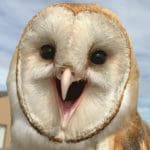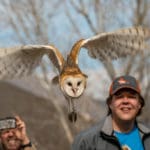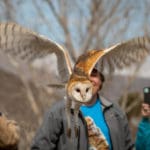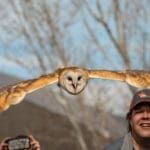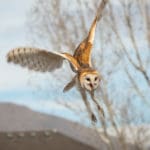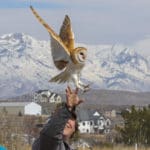On Saturday 2/24/2020 Second Chance Wildlife Rehabilitation released a Barn Owl in Eagle Mountain that was hit by a car in early February in the Magna Utah area. Their Facebook page documents the recovery of this Barn Owl.
- February 5th, 2020 – “Yesterday we admitted this male Barn owl from the Salt Lake valley area. Several people were involved with getting this bird to our facility after being found on the ground at a junior high in the area.”
- February 11th, 2020 – “The male Barn owl from the Magna area is doing well. We had blood pulled on him this past Saturday so we might possibly see why he was in trouble. He will also soon be going out into a large flight for observation. If there are no issues with flight, he will be getting a federal band placed on him and shortly be released.”
- February 19th, 2020 – “This morning we moved our Barn owl out into the 50-foot flight enclosure. He was up on high perches immediately, which tells me it won’t be long until he’s released.”
Chad Welch released the Barn Owl back into the wild in Eagle Mountain. Chad is a volunteer docent with HawkWatch International where he does outreach and education with their ambassador birds. He has also worked with the Eagle Mountain Kestrel project and has also done volunteer work for Second Chance as well.
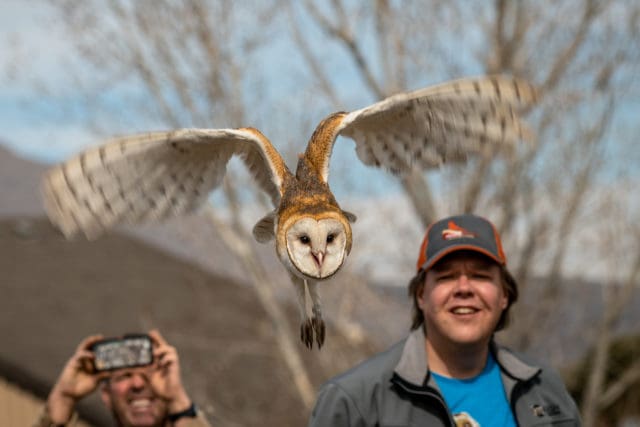
Chad shared this on his Facebook page that he then shared on the Second Chance Facebook page as well. “Not many days can top holding and releasing a barn owl! This bird was hit by a car near Magna and taken to Second Chance Wildlife Rehabilitation in Price. Debbie took great care of the bird until it was ready for release today. Such a beautiful, magnificent bird. Live long and fly high! Thanks Shon Reed with Eagle Mountain Kestrel Project and Eagle Mountain Wildlife for the coordination and opportunity! Please consider donating to Second Chance. There is no profit or government funding in wildlife rehab. They rely solely on donations from us and do such a great job!”
There are several additional photos of the release provided by other bird enthusiasts that participated in the release of this Barn Owl.
The Barn Owl that was released is not completely out of the woods yet. At first, he was thought to be a victim of poisoning which was not the case. Second Chance reported after pickup that, “Time is of the essence in these situations. Though his problems are not obvious, illness and or secondary poisoning is the most probable so flushing the kidneys with fluids was started immediately.” but it was later proven to not be poisoning, but he was probably hit by a vehicle. He could still become a victim of rodenticide. “Rodenticides, colloquially rat poison, are typically non-specific pest control chemicals made and sold for the purpose of killing rodents. Some rodenticides are lethal after one exposure while others require more than one.” Rodenticide is a concern for all birds of prey that have rodents as a food source. As areas are developed, the residents usually declare war on rodents in the area. Rodenticide is left out for those rodents. The birds of prey then eat rodents that are treated with the poison and in essence are poisoning themselves.
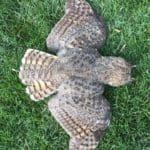 Shon Reed reported this incident of second-hand poisoning in April of 2018. “First, very sorry for this. I know it may be disturbing to some. A tough image to see but a necessary one. There’s nothing like a Great Horned Owl – certainly not an everyday sighting for most of us and for many, a memory that will last for years. Unfortunately, they and other birds of prey fall victim to secondary poisoning when we put down pesticides for voles and other little critters. Please be careful as we move towards warmer weather when these animals start to become evident in our yards. We think we lost two of these huge owls to secondary poisoning last year. This one exhibited signs of poisoning before it finally passed in a front yard in the City Center and the other was found dead above a water source where it likely died trying to quench its thirst. I feel comfortable in saying most of us appreciate the connection we have with nature out here so it is up to us to protect what we cherish. We have a unique situation with many raptors and lots of prey. Please think about not using poison this summer and pulling out your binoculars and posting up your sightings instead.”
Shon Reed reported this incident of second-hand poisoning in April of 2018. “First, very sorry for this. I know it may be disturbing to some. A tough image to see but a necessary one. There’s nothing like a Great Horned Owl – certainly not an everyday sighting for most of us and for many, a memory that will last for years. Unfortunately, they and other birds of prey fall victim to secondary poisoning when we put down pesticides for voles and other little critters. Please be careful as we move towards warmer weather when these animals start to become evident in our yards. We think we lost two of these huge owls to secondary poisoning last year. This one exhibited signs of poisoning before it finally passed in a front yard in the City Center and the other was found dead above a water source where it likely died trying to quench its thirst. I feel comfortable in saying most of us appreciate the connection we have with nature out here so it is up to us to protect what we cherish. We have a unique situation with many raptors and lots of prey. Please think about not using poison this summer and pulling out your binoculars and posting up your sightings instead.”
Cornell Wildlife Health Lab discusses Rodenticide Toxicity. “Although the targets of rodenticides are rodent pests, non-target animals can ingest the products from open bait containers or indirectly become exposed by consuming poisoned rodents. Pets and children are at risk of consuming rodenticides used in the household, and caution should be used when setting household baits to avoid accidental poisoning.
Because animals maintain body stores of blood clotting factors, there is typically a delay of 3-5 days between ingestion of the anticoagulant rodenticides and the onset of bleeding. In many cases of secondary poisoning (ingestion of poisoned rodents), smaller, non-lethal doses are consumed repeatedly. Because these compounds can last in the liver of the animal for months, these repeat exposures may have cumulative effects on coagulation. ”
Rodenticide poisioning are not the only problem that this Owl may now face. But birds of prey are also under attack by lead poisoning. As hunters and shooting enthusiasts shoot in and around Eagle Mountain they also increase the chance of poisoning. Lead bullets and buckshot can also poison these majestic birds’ food sources. There have been numerous reports of birds of prey being killed by lead poisoning. The Utah Department Of Wildlife Resources discusses this. “Lead poisoningLead poisoning causes nervous system damage and digestive system problems and can directly impact the kidneys, liver, blood, reproduction, and immune systems. Symptoms are shaking, weakness, nervous system oddities, brown diarrhea (chocolate milk-like) may occur, high blood pressure, and renal failure. A quick way to diagnose is by drawing the blood and viewing under a black light – the compound created by the presence of lead in the system will cause the blood to fluoresce. More
extensive tests can be done for a definitive diagnosis and analysis of the level of poisoning. X-rays will show any lead bodies in the bird.This necessitates a veterinary visit if your bird has consumed any lead, such as lead shot. The vet will normally treat with a chelating agent to help prevent the lead from entering the system. Peanut butter or Metamucil may be administered to speed the lead through the GI tract.”
Photos
Mike Kieffer – Editor-in-Chief, Cedar Valley Sentinel
Mike Kieffer is a dynamic leader and community advocate based in Eagle Mountain, Utah. He serves as the Editor-in-Chief of the Cedar Valley Sentinel, a local publication dedicated to informing, inspiring, and elevating the Cedar Valley community through honest and accurate journalism. With a passion for fostering connections, Kieffer has made it his mission to highlight local businesses, provide reliable news, and support community development.
Beyond his editorial role, Kieffer is the owner of Lake Mountain Media, LLC, a company specializing in media and communications, and the co-owner of Quail Run Farms, which focuses on sustainable farming and community engagement. He also actively contributes to the local economy and culture as a member of the Eagle Mountain Chamber of Commerce.
Kieffer’s dedication extends to preserving and promoting the history and heritage of the Cedar Valley area. He often participates in community-centered events and media, including podcasts that explore the unique aspects of life in the region. Through his varied endeavors, he remains a steadfast advocate for the growth and enrichment of the local community.

